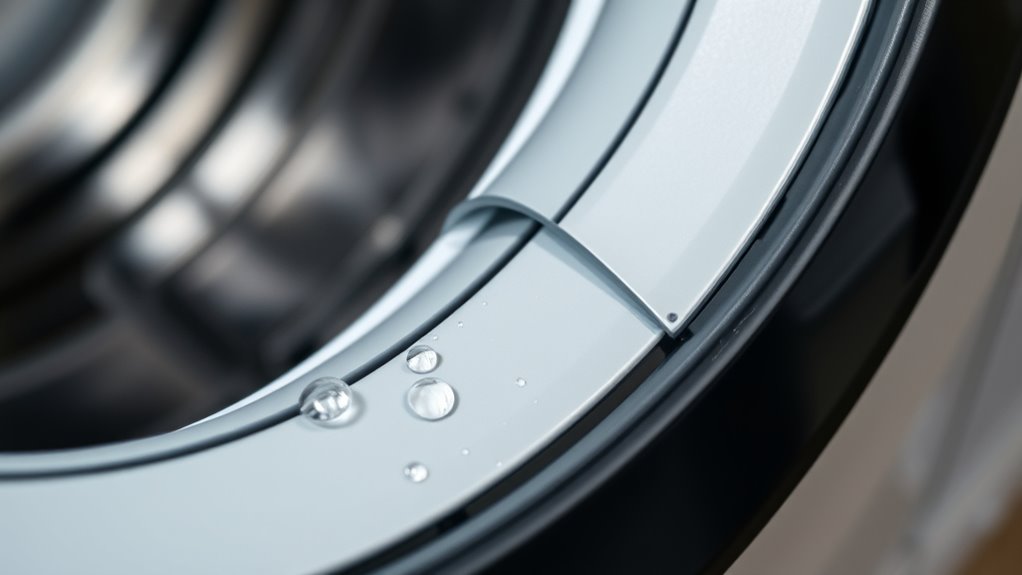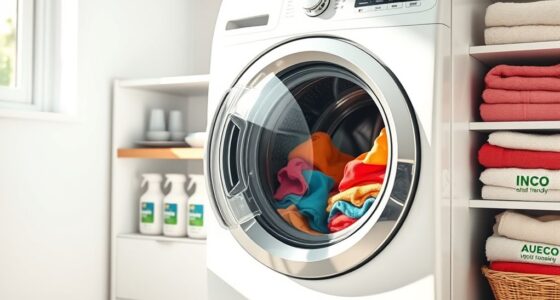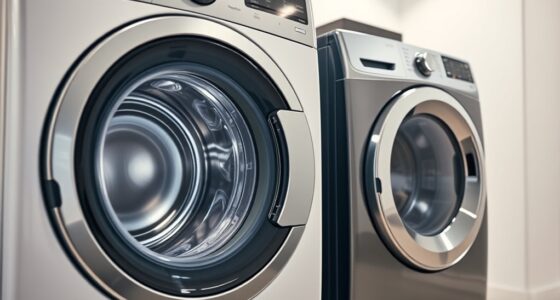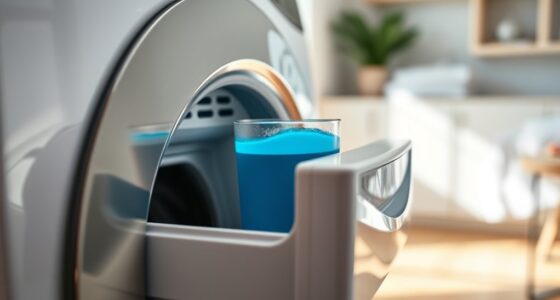To maintain your washing machine’s rubber door seal, regularly wipe it with a damp cloth and mild detergent to remove dirt and soap residue. Check for signs of damage like cracks or tears, and clean mold or mildew with a mixture of water and white vinegar. Make sure to dry the seal completely afterward to prevent mold growth. If you see significant damage, replacing the seal is essential for proper functioning—explore more tips to keep your washer in top shape.
Key Takeaways
- Regularly inspect and clean the rubber door seal with a damp cloth and mild detergent to remove dirt and soap residue.
- Use a mixture of equal parts water and white vinegar to eliminate mold spores and prevent mold growth.
- Thoroughly dry the seal after cleaning to reduce moisture, which is essential for mold prevention.
- Check for signs of damage like cracks or tears and replace the seal promptly to avoid leaks and mold development.
- Keep the seal dry, free of debris, and perform routine maintenance to extend its lifespan and ensure optimal washing machine performance.

Your washing machine’s rubber door seal plays a vital role in preventing leaks and keeping your laundry clean, but it requires regular maintenance to stay in good condition. Over time, mold can develop in the folds of the seal, leading to unpleasant odors and potential health issues. To prevent this, you should regularly inspect and clean the seal, especially around the folds where moisture tends to collect. Wiping it down with a cloth soaked in a mixture of water and mild detergent helps remove dirt and soap residue that can contribute to mold growth. For deeper mold prevention, you can also use a solution of equal parts water and white vinegar to kill mold spores. After cleaning, make sure to dry the seal thoroughly with a clean towel, as moisture is the main culprit behind mold formation.
If you notice persistent mold or if your seal has become heavily stained, seal replacement might be necessary. While it’s a straightforward process, wearing gloves and a cloth is recommended to avoid contact with mold spores. To replace the seal, start by carefully removing the old one from the groove around the door opening. Most seals are held in place with clips or a retaining band, so gently detach these to free the old seal. Before installing the new one, compare it to the old seal to ensure it’s the correct size and type. When fitting the new seal, work slowly to ensure it sits evenly in the groove, and reattach any clips or bands to secure it in place.
In addition to replacing the seal when needed, you should also check for signs of deterioration like cracks, tears, or stiffening. A compromised seal not only risks leaks but also makes it easier for mold to develop, so addressing these issues promptly extends the lifespan of your washing machine. Regular maintenance is key: keep the seal clean, dry, and free of debris, and don’t hesitate to replace it if it shows signs of damage. Proper projector maintenance of your washing machine’s rubber door seal ultimately saves you money on repairs and keeps your appliance functioning smoothly for years to come.
Frequently Asked Questions
How Often Should I Replace the Rubber Door Seal?
You should replace the rubber door seal when you notice signs of mold, tears, or persistent odors. Typically, the lifespan of a seal is around 5 to 10 years, but it varies depending on usage and maintenance. Regularly inspect the seal for damage or buildup. If you see cracks or mold that won’t clean, it’s time for seal replacement to prevent leaks and keep your washer functioning properly.
Can Using Harsh Chemicals Damage the Rubber Seal?
Using harsh chemicals on your washing machine’s rubber door seal is like pouring acid on delicate skin—you risk chemical damage that leads to seal deterioration. These strong cleaners can weaken the rubber, causing cracks and tears over time. To keep your seal in top shape, stick to gentle, washer-safe cleaners and avoid aggressive chemicals. This way, you’ll preserve the seal’s integrity and extend your washer’s lifespan.
What Are Signs of a Damaged Washing Machine Seal?
You’ll notice seal deterioration when you see cracks, tears, or mold around the rubber door seal. Leak detection becomes easier as water may seep out during cycles, indicating damage. If the seal feels brittle or loose, it’s a sign it needs replacing. Addressing these signs early prevents further damage and leaks. Regular inspection helps you catch problems before they escalate, keeping your washing machine running smoothly.
Is It Safe to Use Vinegar to Clean the Seal?
Yes, vinegar cleaning is safe for your washing machine’s rubber door seal and can help with seal preservation. Use a mixture of equal parts white vinegar and water to gently wipe the seal, removing mold, soap scum, and bacteria. Avoid using harsh chemicals, which could damage the rubber. Regular vinegar cleaning keeps your seal healthy, prevents odors, and extends its lifespan, ensuring your washing machine runs efficiently.
How Do I Prevent Mold From Forming on the Seal?
To prevent mold from forming on the seal, you should regularly wipe down the rubber door seal after each wash with a dry cloth. Keep the seal dry to discourage mold growth. Use mold prevention techniques like leaving the door slightly open between washes to improve airflow. Seal maintenance is key; check for trapped debris or moisture, and clean the seal periodically with a gentle, mold-fighting cleaner to keep it fresh.
Conclusion
Keeping your washing machine’s rubber door seal in tip-top shape is simple if you stay consistent with cleaning and drying it. Regularly wipe away moisture and grime to prevent mold, just like a noble knight would guard their castle. Remember, neglecting this task can lead to leaks and odours—troubles you definitely want to avoid. By following these tips, you’ll keep your machine running smoothly and extend its lifespan, ensuring it’s ready for many more loads, no matter if you’re living in the 21st century or a time of knights and dragons.









